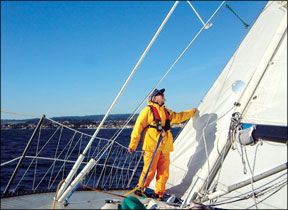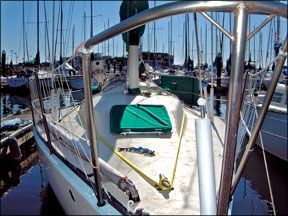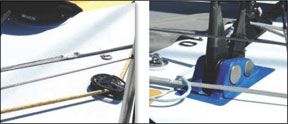Whatever jackline system is used, it should be supplemented with fixed clip-in points in the cockpit, at the helm, and around the mast-wherever crew members work for extended periods. International Sailing Federation recommendations require that two-thirds of the crew be able to be simultaneously clipped on without depending on jacklines. Our top choice is a low-stretch Dyneema or Spectra jackline custom made by a professional with loops bartacked in place. For those on a budget, low-stretch polyester jacklines like those made by one of our recommended suppliers will suffice. In either case, routine inspection for wear and UV damage is imperative.
***

288
Whether made of wire, rope, or webbing, a good jackline system provides a secure, convenient, and continuous means of attachment for safety harness tethers while crew members are on deck. As your life may depend on a jackline keeping you aboard, it should be made of strong and low-stretch material, be kept as taut as possible, and be routed inside the shrouds down both sides of the deck as close to the centerline as possible.
Ideally, jacklines would be located to allow a harnessed and tethered crew to reach the rail, but not beyond. Once a crew goes over the lifelines and into the water, recovery becomes vastly more difficult. It is always good practice to clip onto the windward side jackline to minimize the chances of going over the side.
Because jacklines attract dirt and grime, are subject to UV degradation, abrasion, and chafe, and can provide a potential ankle-spraining hazard, offshore cruisers and racers wisely remove their jackline systems when not in use.
Jacklines can be secured to the boat at most strong and through-bolted attachment points such as the stem head fitting, mooring cleats, windlass, U-bolts, and padeyes. Using lifelines as jacklines is not recommended due to the necessity of frequent clipping and unclipping of the tether hook while passing stanchions. Lifelines used as jacklines are also too close to the rail of the boat for safety. In the event of crew being launched overboard by an off-balance fall or breaking wave, a tether clipped to a lifeline would likely break off the stanchion, uproot the stanchion base, or otherwise damage the lifeline system, making man-overboard recovery even more difficult.
An excellent method to terminate the aft end of a jackline is lashing it to a padeye. Lashing allows adjustment and tensioning of the jackline, as well as easy removal. A valid argument can be made that jacklines should end 6 to 8 feet forward of the stern so a man-overboard cannot be dragged and drowned behind the boat.
This scenario unfortunately occurred in the 1999 double-handed Farallones Race off San Francisco when five people were washed off their boats. (To read more about this, visit www.psych.sjsu.edu/~mvselst/sailboat/farallones.htm
or www.ussailing.org/safety/Rescues/3_1_
99dhfarallones_ca.htm.) However, if there is reboarding access from the transom-a fold-down ladder or transom steps-consideration must be given as to whether the combined length of the tether and jackline will permit retrieval of a man-overboard over the stern.

288
A notable consideration for jackline installation is the International Sailing Federation (ISAF) recommendation that two jacklines be fitted on the underside of multihulls in case of capsize. In such a case, jacklines would not only provide security on a slippery bottom barren of hand- and footholds, but also provide additional means of boarding and reboarding. For monohulls, ISAF recommends using wire or webbing jacklines of specific size and strength.
Over the years, much consideration has been given as to what is the best material and location for jacklines. This has led to some innovative and ill-advised approaches: In the mid-1980s, Dodge Morgan, during his nonstop solo-circumnavigation on American Promise, used Harken traveler tracks and ball-bearing sliders as jacklines. These tracks and sliders, to which Morgan attached his tether, ran nearly the full length of the boat on both sidedecks. The downside to an attachment point free of friction is just that-it allows a person hit by a sea to fly down the deck with no deceleration-they might as well be on a skateboard. The track system was expensive and a step in the wrong direction, in our opinion.
Jacklines can be made from a variety of materials. The most frequently used are wire, rope, and webbing. Here is a review of jackline materials and their pros and cons:
WIRE
ISAF specifies jackline wire be 1×19 stainless steel with a minimum 3/16-inch diameter, uncoated, and used without any sleeving.
PROS: Wire jacklines offer minimum stretch, are easy to clip into, and are not subject to UV degradation.
CONS
: Wire can roll out from underfoot when stepped on, and its hard to see at night when clipping in. The 1×19 wire jacklines require swaged marine eye terminals at both ends. These terminals present potential for stress concentration and metal fatigue at the wire/terminal junction as a result of jackline movement. While low-stretch jacklines are a must, wire offers virtually no stretch, meaning it doesn’t have enough elasticity to absorb shock.ROPE
Rope is an OK choice for jacklines, as it is readily handy, and easily stows and attaches to deck fittings. Even mooring lines, serving a dual purpose, can be used for jacklines-though we don’t advise this.
PROS
: This material is the least expensive and the easiest to rig with knots or to secure to cleats.CONS
: Other running rigging, such as jib and spinnaker sheets, can be mistaken for rope jacklines. Rope vulnerable to UV rays and chafe, and knots reduce the strength of the rope. Rope, like wire, has a tendency to roll underfoot.If rope is used, it should be low-stretch, a color that contrasts with the deck, and of sufficient diameter to account for a 50-percent loss of strength at knots.
WEBBING

288
Webbing, the modern day standard for jacklines, is probably the best choice. ISAF recognizes the benefits of webbing and specifies that webbing jacklines have a breaking strength of at least 4,500 pounds.
PROS
: Webbing, which is soft and easily stowed, lays flat on the deck and is the least likely material to be tripped over. It contrasts with other running rigging.CON
: Over time, webbing likely will suffer from UV degradation. As with all jackline materials and other safety gear, before each use the webbings integrity should be checked for signs of wear and weakness.Webbing Choices
When selecting webbing for jacklines, choose a color in contrast with the deck. Hathaway, Reiser and Raymond, West Marine, and Wichard, among others, offer low-stretch, yellow polyester jacklines. C-Level makes them in red.
Both polypropylene and 1-inch tubular nylon webbing should be avoided for jackline use. Polypro is not nearly as strong as polyester and suffers greatly from UV degradation. One-inch tubular nylon webbing-breaking strength 3,600 pounds-is very elastic and does not meet ISAF minimum strength requirements.
In Practical Sailor tests, a 190-pound crew member was dragged astern from 25-foot jacklines made of 1-inch, 3,600-pound tubular nylon webbing, and 1-inch, 6,000-pound West Marine polyester webbing. The nylon webbing stretched 6 percent when dry and 7 percent when wet, while the polyester webbing stretched less than 1 percent, wet and dry.
High stretch can be dangerous in jacklines because deck work using a tether as a “third leg” brace is compromised with a stretchy jackline. Stretch is also dangerous as it increases the length of the tether/jackline combination to an extent that a man overboard may be dragged farther from the boat.
An excellent, but expensive, option for custom jacklines is the use of low-stretch Spectra or Dyneema webbing. These high-tech materials are incredibly strong, offer good UV and abrasion resistance, and absorb almost no water. Available from climbing stores and sailmakers, Spectra or Dyneema webbing is very slippery under high load and may not hold knots well. When high-tech webbing is used for jacklines, it should have sewn loops bar-tacked in place. Other high-tech webbing materials such as Kevlar or Vectran webbing are less desirable for jacklines primarily due to their poor resistance to UV.
Conclusion
Our top choice is a low-stretch Dyneema or Spectra jackline custom made by a professional with loops bartacked in place. For those on a budget, low-stretch polyester jacklines like those made by the manufacturers listed below are acceptable. In either case, routine inspection for wear and UV damage is imperative.
Whatever jackline system is used, it should be supplemented with fixed clip-in points in the cockpit, at the helm, and around the mast-wherever crew members work for extended periods. ISAF requires that two-thirds of the crew be able to be simultaneously clipped on without depending on jacklines. ISAF also requires that crew members be able to clip-on before going on deck and able to unclip after going below.
A good solution to this fixed clip-in point requirement is the Wichard folding padeye, through-bolted with a backing plate.
Jacklines are not visually exciting for a boats decor. But as your life may depend on them, their importance cannot be overstated.







































